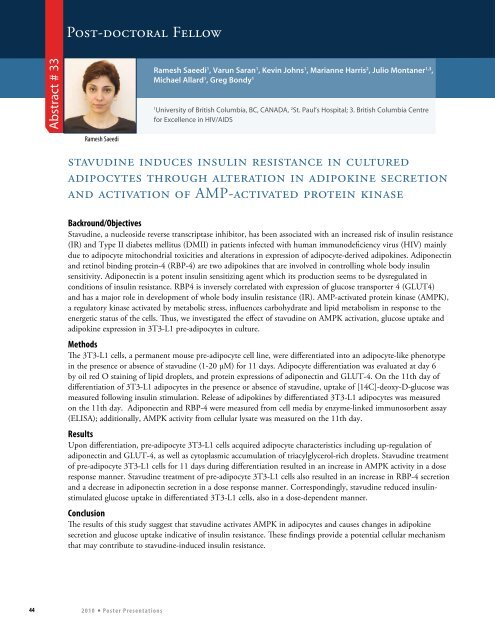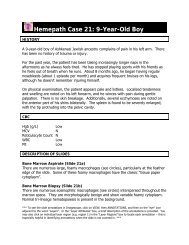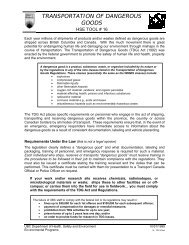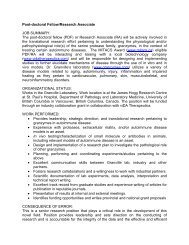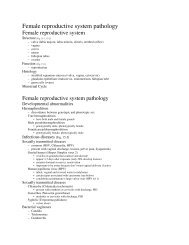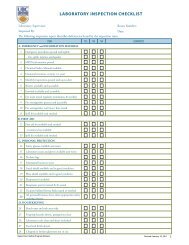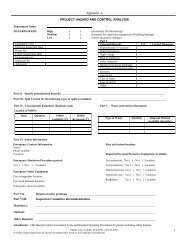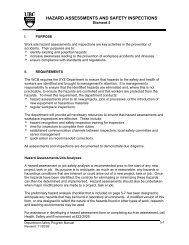Oral Presentations - Pathology and Laboratory Medicine - University ...
Oral Presentations - Pathology and Laboratory Medicine - University ...
Oral Presentations - Pathology and Laboratory Medicine - University ...
Create successful ePaper yourself
Turn your PDF publications into a flip-book with our unique Google optimized e-Paper software.
Post-doctoral FellowAbstract # 33Ramesh Saeedi 1 , Varun Saran 1 , Kevin Johns 1 , Marianne Harris 2 , Julio Montaner 1,3 ,Michael Allard 1 , Greg Bondy 11<strong>University</strong> of British Columbia, BC, CANADA, 2 St. Paul’s Hospital; 3. British Columbia Centrefor Excellence in HIV/AIDSRamesh Saeedistavudine induces insulin resistance in culturedadipocytes through alteration in adipokine secretion<strong>and</strong> activation of AMP-activated protein kinaseBackround/ObjectivesStavudine, a nucleoside reverse transcriptase inhibitor, has been associated with an increased risk of insulin resistance(IR) <strong>and</strong> Type II diabetes mellitus (DMII) in patients infected with human immunodeficiency virus (HIV) mainlydue to adipocyte mitochondrial toxicities <strong>and</strong> alterations in expression of adipocyte-derived adipokines. Adiponectin<strong>and</strong> retinol binding protein-4 (RBP-4) are two adipokines that are involved in controlling whole body insulinsensitivity. Adiponectin is a potent insulin sensitizing agent which its production seems to be dysregulated inconditions of insulin resistance. RBP4 is inversely correlated with expression of glucose transporter 4 (GLUT4)<strong>and</strong> has a major role in development of whole body insulin resistance (IR). AMP-activated protein kinase (AMPK),a regulatory kinase activated by metabolic stress, influences carbohydrate <strong>and</strong> lipid metabolism in response to theenergetic status of the cells. Thus, we investigated the effect of stavudine on AMPK activation, glucose uptake <strong>and</strong>adipokine expression in 3T3-L1 pre-adipocytes in culture.MethodsThe 3T3-L1 cells, a permanent mouse pre-adipocyte cell line, were differentiated into an adipocyte-like phenotypein the presence or absence of stavudine (1-20 µM) for 11 days. Adipocyte differentiation was evaluated at day 6by oil red O staining of lipid droplets, <strong>and</strong> protein expressions of adiponectin <strong>and</strong> GLUT-4. On the 11th day ofdifferentiation of 3T3-L1 adipocytes in the presence or absence of stavudine, uptake of [14C]-deoxy-D-glucose wasmeasured following insulin stimulation. Release of adipokines by differentiated 3T3-L1 adipocytes was measuredon the 11th day. Adiponectin <strong>and</strong> RBP-4 were measured from cell media by enzyme-linked immunosorbent assay(ELISA); additionally, AMPK activity from cellular lysate was measured on the 11th day.ResultsUpon differentiation, pre-adipocyte 3T3-L1 cells acquired adipocyte characteristics including up-regulation ofadiponectin <strong>and</strong> GLUT-4, as well as cytoplasmic accumulation of triacylglycerol-rich droplets. Stavudine treatmentof pre-adipocyte 3T3-L1 cells for 11 days during differentiation resulted in an increase in AMPK activity in a doseresponse manner. Stavudine treatment of pre-adipocyte 3T3-L1 cells also resulted in an increase in RBP-4 secretion<strong>and</strong> a decrease in adiponectin secretion in a dose response manner. Correspondingly, stavudine reduced insulinstimulatedglucose uptake in differentiated 3T3-L1 cells, also in a dose-dependent manner.ConclusionThe results of this study suggest that stavudine activates AMPK in adipocytes <strong>and</strong> causes changes in adipokinesecretion <strong>and</strong> glucose uptake indicative of insulin resistance. These findings provide a potential cellular mechanismthat may contribute to stavudine-induced insulin resistance.44 2 0 1 0 * P o s t e r P r e s e n t a t i o n s


